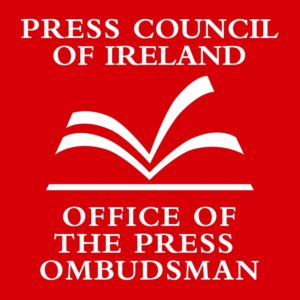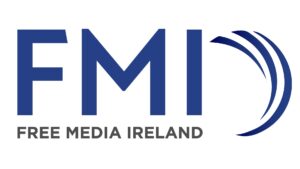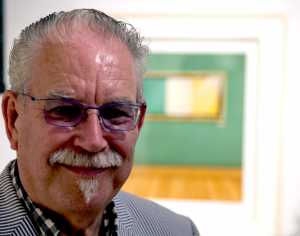
Picture: Keith Wiseman
THE Hunt Museum is home to Robert Ballagh’s visual art responses to The Rising – and Ireland since – in ‘A Terrible Beauty: A Centennial Reflection’ until the end of August. Limerick scored in securing this spread of enormous Pop Art oils, bronze medallions and portraits of the signatories of The Proclamation. Meet his Laochra na mBan, whose sidelining from history grieves him.
Whatever you think of 1916, that Ballagh is a great original master is indisputable. Read Ballagh’s ‘A Proclamation for 2016’ and ponder his strategy for a nation’s salvation.
Despite of or because of his history steeped in social activism, he has been the Establishment’s ‘go-to’ artist for decades, designing portraits for Central Bank currency, stamps for An Post, bronze busts for the State, monuments for Glasnevin. Ballagh’s work has been spent, licked, looked at and prayed to by millions. Commissions were either invited or won in closed anonymous competition.
His span is wide. Moya Doherty asked him to design the theatrics for Riverdance. Michael Colgan of The Gate came to him for Barry McGovern’s emotive take on Beckett’s ‘I’ll Go On’.
In Limerick to open ‘A Terrible Beauty’, he gave a public talk on ‘Artists of 1916’, illustrating the contribution of Michael Farrell, Constance Markievicz, Willie Pearse, Patrick Tuohy, Andrew Shepherd, Limerick’s Tom Ryan, Sean Keating and more. The Dubliner is warm, witty and the wisecracks hit home. He loves his country.
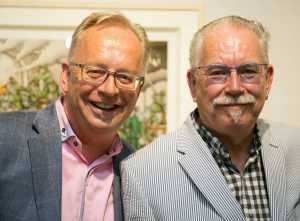
Picture: Keith Wiseman
Ballagh on the FF/FG coalition: “They must be the worst government for the Arts in the history of the state with this demotion of the Arts to an afterthought.” Ref. Dept of Regional Development, Rural Affairs, Arts and the Gaeltacht.
On the Irish Presidency: “I think the presidency is the one aspect of our Constitution that has worked”.
He has concerns with the survival of culture here, puzzling over what is taught in art schools, and visual artists making a living (“virtually impossible”). But for this interview, was upbeat sunshine outside The Hunt Café. Clothes are dapper and he edits nothing in speech.
His antecedents are Limerick. Grandfather Ed Bennett, great uncle Jim and he loved his summers “as a Dublin city boy” in Patrickswell, on the farm of great aunt Ada Furnell and her house filled with paraphernalia.
“There was no electricity, no water and I became intensely attached to the farm labour Billy”, riding on donkey carts and filling milk churns with water for the household. The loo was outdoors, which makes him chuckle over past experience.
After a bad Leaving Cert, his parents told him they “would back him in any career choice but the one you cannot do is art”.
Already playing guitar, he filled place No. 28 of 30 in Bolton Street for architecture. Being accepted surprised the lights out of him. “I enjoyed [the course], learnt a lot, then fell foul of my tutors when in 3rd Year. Almost in the same moment that I gave up architecture I became a professional musician, working in the showband scene”.
What? “Well, there was nothing else then. I gave it up in 1966 but there was no coincidence with the semi-centennial [1916]. I sold my bass guitar to Phil Lynott who was just a kid starting out. Lovely guy. Lovely.” And he looks away, sad.
That’s Ballagh’s guitar, clutched for eternity in iconic photos of the rock god.
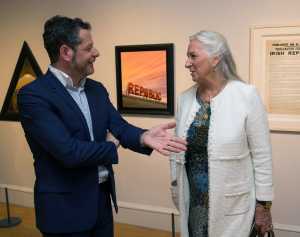
John Moran, chair of the Board at the Hunt Museum with Lady Geraldine Dunraven.
Picture: Keith Wiseman
Working, his favourite technique seems to be portrait, the intimacy the exercise affords as much as the discipline. “I have done a lot of portraits and have met some truly fantastic people and these are the works that mean most to me. In 1985 I did Noel Browne’s portrait and became very friendly with him and his wife Phyllis.
“More recently I was commissioned to do James Watson who discovered the structure of DNA with Francis Crick”. Nobel Prize winners both, he went on to do Crick’s for the scientist’s eponymous institute.
Oil paint is Ballagh’s thing: “I work with it as much as I can. Oils are a medium invented only 500 years ago. Most artists are working alla prima, I work with glazes in a variety of tones and colours and it takes for ever. Crick’s portrait took six months”.
Then a summons to carriage: Con Colbert Station’s 16.50 took hostage for The Pale.
Interview by Rose Rushe



